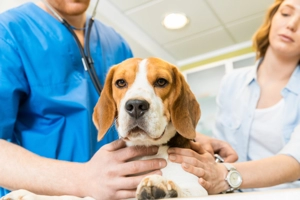We love our pets. They are part of our family. So, as part of the family, we do everything that we can to make sure that they are safe.
But, what if we don’t see the danger…or smell it? Some of the scariest things are the things that we never see coming. And one of those common household dangers is carbon monoxide.
We know the dangers for humans, but what about our beloved pets? Does carbon monoxide affect them as well? Specifically, can dogs smell carbon monoxide?
Yes, dogs can smell carbon monoxide. This does NOT mean that they can identify the gas – carbon monoxide is completely odorless and colorless. But it does mean that they can detect the presence of carbon monoxide in the air and at lower levels than we can.
In addition, not only do dogs detect CO but they are also more quickly and seriously affected by it than us.
So let’s look at a few things to look out for and some simple precautions to keep this deadly danger from affecting your family.
How Do Dogs Act When They Detect Carbon Monoxide?
Dogs can detect the presence of carbon monoxide in the air and at lower levels than we can.
This “detection” is in the form of being more susceptible to the effects of carbon monoxide poisoning. This is because their bodies are not as efficient at getting rid of CO and having a much higher respiratory rate than humans.
For some reason, when dogs “smell” carbon monoxide, they often act differently than when exposed to other smells.
Some symptoms of carbon monoxide poisoning in dogs can include lethargy, difficulty breathing, confusion, and they can even collapse.
In other cases, a dog could become more alert and even begin to get agitated. They may try to leave the area or attempt to escape the area if possible. As stated before, dogs can also become lethargic, weak, and disoriented when exposed to high levels of carbon monoxide.
If the levels are especially high, dogs can even experience seizures or respiratory distress due to carbon monoxide poisoning. When around sources of carbon monoxide (fumes from car or small engine fuel, gas stoves, lanterns, grills, fireplaces, furnaces etc.) it is very important for owners to be aware of any changes in their pet’s behavior.
It is important to seek veterinary care immediately if you think that your dog might be experiencing the effects of carbon monoxide. CO poisoning can be fatal if left untreated in pets or humans.
How Fast Can Carbon Monoxide Affect Dogs?
Carbon monoxide should not be underestimated! It is a deadly gas and can affect dogs very quickly.
Of course, depending on the concentration of the gas, it can take anywhere from minutes to hours for the first symptoms to show.
In general, the higher the concentration, the faster it can take effect. Death can occur in minutes if the toxicity is high enough. The most common symptoms that occur when a dog has been exposed to especially high levels of carbon monoxide are vomiting, disorientation, lack of coordination, and labored breathing or panting.
If you think that your dog may have been exposed and see any of these signs, seek veterinary care as soon as possible. To help ensure that your family, including your pets stay safe, install carbon monoxide detectors in your home as a preventative measure.
Can Dogs Die From Carbon Monoxide Poisoning?
Absolutely dogs can die from carbon monoxide poisoning – just like humans!
To help prevent this from happening, it is very important to install a carbon monoxide alarm in your home to detect any dangerous levels of this deadly gas.
Another thing that will help is to follow a regular maintenance program for all fuel-burning appliances.
By taking these precautionary steps you will help protect not only your beloved pet but your entire family from the risks associated with carbon monoxide poisoning.
How Do You Treat Carbon Monoxide Poisoning In Dogs?
While getting them to fresh air and away from carbon monoxide is the first step to take, treatment must be done professionally.
The primary method is oxygen therapy which involves giving the dog supplemental oxygen. This can be either via a mask or a tube placed in their trachea. They may also need medications to help reduce swelling and inflammation.
In extreme cases, blood transfusions may be needed to restore normal levels of red blood cells. Supportive care like IV fluids and monitoring the dog’s vital signs are essential parts of treatment.
If not treated, carbon monoxide poisoning can lead to long-term health issues such as neurological damage and even organ failure. To give them the best chance of making a full recovery it is critical that dogs exposed to carbon monoxide poisoning receive immediate medical attention.
How To Prevent Carbon Monoxide Poisoning
Because of how dangerous and fatal the result of carbon monoxide poisoning is, the best thing to do is to prevent it from happening in the first place. How?
The most important thing you can do is to install a carbon monoxide alarm in your home. These devices are designed to detect dangerous levels of carbon monoxide in the air and then alert you so that you can take action quickly.
Additionally, having a regular schedule of maintenance on all fuel burning appliances such as furnaces, stoves, fireplaces, and water heaters will help to ensure that they are free from dirt and debris and are working properly.
Make sure there is enough ventilation around these appliances as well.
It seems obvious but never use charcoal grills or portable generators indoors or in enclosed spaces like garages or sheds.
By taking these precautions you can help to reduce the risk of carbon monoxide poisoning to your pets and entire family.

